| Author |
Message |
    
searcher
Senior Member
Username: searcher
Post Number: 127
Registered: 10-2004
| | Posted on Monday, July 24, 2006 - 12:03 am: | 




|
A year ago, I acquired an old marine engine that came with a 10 gallon tank. I set the tank to one side and paid no further attention to it, thinking that it was galvanized sheet metal with a greenish tinge from weathering. On a closer look recently, I discovered that it is actually brass. I would not live long enough to polish it up with Brasso as the surface oxidation is quite thick. Is there any spray on or brush on chemical available that would remove the bulk of that oxidation so the surface would be easier to polish? |
    
solarrog
Senior Member
Username: solarrog
Post Number: 165
Registered: 03-2002

| | Posted on Monday, July 24, 2006 - 12:13 am: | 




|
I have used sulfuric acid, It only takes a minute or so, you will then be able to rub the oxidation off. glove, face shield, outside are all required. flush with baking soda afterwords
use lots of water afterwords. using acid is dangerous, If you do not know how find some other way. |
    
rosey
New member
Username: rosey
Post Number: 3
Registered: 07-2006

| | Posted on Monday, July 24, 2006 - 02:17 am: | 




|
In Australia we have a hull cleaner product that is on the market. I have used it successfuly to take off scum as well as exhuast stain. It wouldn't be as harsh as sulphuric acid. The other method is to use a linnisher attachement on a power tool. |
    
searcher
Senior Member
Username: searcher
Post Number: 128
Registered: 10-2004
| | Posted on Monday, July 24, 2006 - 11:06 am: | 




|
Solarog and Rosey,
Thanks for the suggestions. I will try to locate a hull cleaner as the first choice. I am glad to know about the sulfuric acid though. I have had considerable laboratory experience so am familiar with using strong acids. I wouldn't hesitate to try sulfuric acid on a smaller object. For instance, I have a Schebler carburetor with a heavy oxidation coating on it that I will try the acid on. I avoid wire brushing as much as I can due to a strong reaction to the dust from brass, copper, etc. |
    
keith
Senior Member
Username: keith
Post Number: 129
Registered: 02-2002

| | Posted on Tuesday, July 25, 2006 - 10:47 am: | 




|
Searcher
Vinegar with a little salt added works great on small items |
    
searcher
Senior Member
Username: searcher
Post Number: 129
Registered: 10-2004
| | Posted on Tuesday, July 25, 2006 - 08:21 pm: | 




|
A fellow from Australia e-mailed me directly that he also had used vinegar for the purpose. So, I bought a gallon of store brand white vinegar tonight and will soak a Schebler in it starting tomorrow. I will take a few photos of the progress and post them if it works. Thanks Keith and Garry. |
    
searcher
Senior Member
Username: searcher
Post Number: 158
Registered: 10-2004
| | Posted on Sunday, October 22, 2006 - 01:00 am: | 




|
The following photos document a little experiment I did with vinegar and a household cleaner sold as CLR (stands for Calcium, Lime, Rust).
A bit of research indicates that there are several organic acids capable of forming a chelate (in chemistry, a chelate is a ring structure that holds a metal ion in the center of the ring). The group includes acetic acid, lactic acid, and gluconic acid among others.
Vinegar is dilute acetic acid. The active ingredients in CLR are lactic acid (found in fermenting milk) and gluconic acid (produced by the oxidation of glucose, a common sugar). The safety label on the CLR indicates the same standard precautions found on most household cleaning products.
Clearly, both CLR and vinegar would do the job. CLR is much more expensive than vinegar but is faster and has virtually no odor. Vinegar appears to be the gentler of the two if a long soaking is in order.
There doesn't seem to be any great advantage in soaking brass or copper in the CLR for long periods. After 30 minutes to an hour in the CLR, the coating on brass and copper scrubbed off easily with fine steel wool and minimal effort.
Obviously, it is impractical to submerse bulky objects such as the brass gasoline tank. The solution to that problem was to cover a large area of the tank with several layers of paper towel and then pour either the vinegar or CLR onto the paper towel and let it soak.
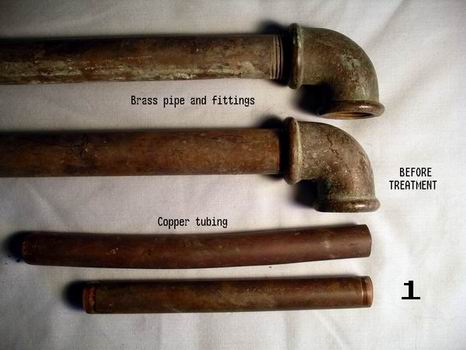
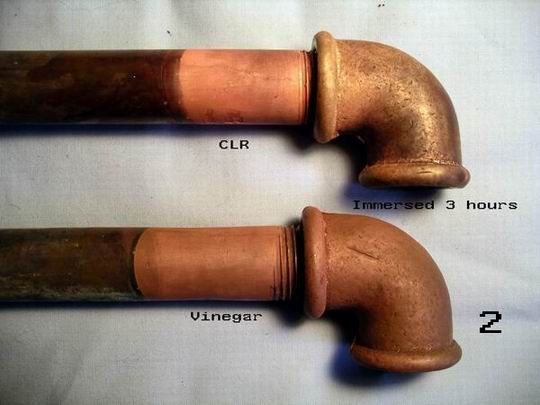
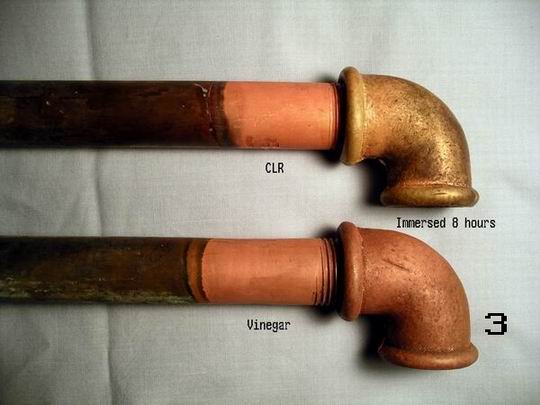
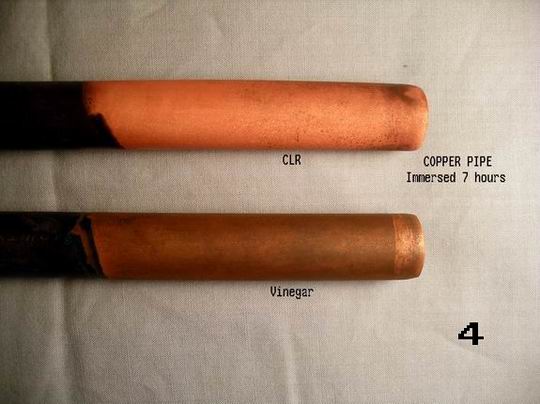

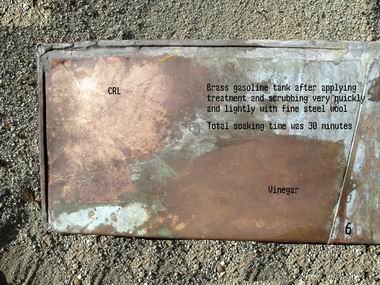 |


